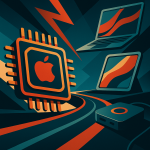Key Points
- The Ministry of Industry and Information Technology (MIIT – 工业和信息化部) has launched an “AI+Manufacturing” action plan to integrate AI deeply into China’s manufacturing sector.
- A key focus is developing Industrial Intelligent Entities (Gōngyè Zhìnéng Tǐ 工业智能体), seen as sophisticated AI systems for driving innovation and application in industry.
- The plan involves turbocharging digital upgrades, boosting software and hardware capabilities (like industrial software and smart sensors), and accelerating the construction of industrial datasets.
- Initiatives include driving enterprise transformation across supply chains and implementing a “Hundred Cities” (Bǎi Chéng 百城) pilot for SME digitalization.
- MIIT aims to strengthen support systems including standards, talent cultivation, investment, and fostering an innovative atmosphere for AI adoption in manufacturing.

Get ready for a major leap in China’s industrial landscape!
The Ministry of Industry and Information Technology (MIIT – Gongye He Xinxi Hua Bu 工业和信息化部) is rolling out a game-changing initiative: the “AI+Manufacturing” action plan, designed to deeply integrate artificial intelligence into the nation’s manufacturing DNA and foster the development of sophisticated Industrial Intelligent Entities (Gōngyè Zhìnéng Tǐ 工业智能体).
This forward-looking strategy, unveiled at a high-level working group meeting on June 6, 2025, signals a massive push towards smart, efficient, and innovative industrial practices.
MIIT Sets the Stage: A Strategic Push for New Industrialization in China
The meeting, helmed by Li Lecheng (Li Lecheng 李乐成), Secretary of the Party Group and Minister of MIIT, wasn’t just another bureaucratic sit-down.
It was a strategic pow-wow to implement the directives of General Secretary Xi Jinping (Xi Jinping 习近平) on the deep integration of informatization and industrialization.
The key agenda? To review the “Key Work Points for the Integration of Informatization and Industrialization of the Ministry of Industry and Information Technology in 2025” and lay down the battle plan for this ambitious AI integration.
Ministry leaders Xiong Jijun (Xiong Jijun 熊继军) and Xie Shaofeng (Xie Shaofeng 谢少锋) were also present, underscoring the initiative’s importance.
The core message was clear: informatization and industrialization integration isn’t just a buzzword.
It’s a strategic imperative for promoting China’s new industrialization and accelerating the development of new quality productive forces.
It’s about leveraging integration to drive innovation and build fresh momentum in the manufacturing sector.

Find Top Talent on China's Leading Networks
- Post Across China's Job Sites from $299 / role
- Qualified Applicant Bundles
- One Central Candidate Hub
Your First Job Post Use Checkout Code 'Fresh20'

The “AI+Manufacturing” Blueprint: What’s Under the Hood for China’s Industries?
So, what does this “AI+Manufacturing” push actually involve?
The MIIT laid out a comprehensive roadmap, emphasizing a reform and innovation-driven approach. Here’s the breakdown:
1. Turbocharging Digital, Networked, and Intelligent Upgrades Across Manufacturing
- Industry-Specific Digital Transformation: Rolling out digital transformation plans for key industries, focusing on scene-by-by-scene and mapping-based approaches in manufacturing. Think bespoke digital makeovers for entire sectors.
- Scaling the Industrial Internet: Accelerating the application of industrial internet by strengthening its five core functional systems: network, identification, platform, data, and security. This is about building the robust digital highways for industry.
- “AI+Manufacturing” in Action: Implementing the flagship action to speed up intelligent upgrading in crucial industries. The goal is an “upgraded version” of intelligent manufacturing. This hints at moving beyond basic automation to truly smart factories leveraging AI.
2. Beefing Up Software and Hardware Capabilities for AI Dominance
- Core Tech Breakthroughs: Doubling down on R&D for key technologies like industrial software and smart sensors. These are the brains and nerves of modern, AI-enhanced manufacturing.
- High-Quality Industrial Datasets: Accelerating the construction of robust industrial datasets. Why? Because AI is hungry for data, and quality data is the bedrock for effective industrial AI applications.
- Agile Digital Tools: Intensifying efforts to cultivate “small, fast, light, accurate” digital products and low-cost digital general tools. This is crucial for making digital transformation accessible, especially for smaller players looking to adopt AI.
3. Deepening AI Industrial Application with “Industrial Intelligent Entities”
- The Rise of Industrial Intelligent Entities (Gōngyè Zhìnéng Tǐ 工业智能体): This is a standout concept. These “entities” are envisioned as a key lever to drive the industrial application of AI in China.
- Driving Innovation: Leveraging these intelligent entities to spur innovative iterations of industrial datasets and industrial large models. This suggests a focus on creating specialized AI models trained on specific industrial data.
Insight for founders and investors: The term “Industrial Intelligent Entities (Gōngyè Zhìnéng Tǐ 工业智能体)” is one to watch.
It likely refers to sophisticated AI systems, advanced digital twins, or autonomous agents deeply embedded in industrial processes.
This could be a hotbed for new tech development and investment opportunities in the AI and manufacturing space.
4. Sparking Enterprise Transformation & Upgrading with AI and Digital Tools
- “Chain-Like” Transformation: Leveraging leading enterprises to drive digital transformation across entire supply chains (both upstream and downstream). This recognizes the interconnectedness of modern industry and the network effects of AI adoption.
- SME Digitalization Drive: Deeply implementing the special action for the digital transformation of small and medium-sized enterprises (SMEs). This includes earnestly carrying out the “Hundred Cities” (Bǎi Chéng 百城) pilot work – a significant nationwide initiative.
- Cultivating Expert Service Providers: Nurturing a batch of service providers who understand both industry-specific needs and digitalization. Bridging the gap between AI tech and traditional manufacturing is key.
Data Point to Note: The “Hundred Cities” (Bǎi Chéng 百城) pilot suggests a widespread, targeted effort to uplift SMEs, which form the backbone of China’s economy.
Success here could significantly boost national productivity through broader AI and digital tool adoption.
5. Strengthening Support Systems for AI-Driven Manufacturing: Factors, Resources, and Atmosphere
- Standards for Innovation: Condensing the results of informatization and industrialization integration innovation into clear standards. This supports businesses in researching, implementing, and using these AI and manufacturing standards effectively.
- Talent Pipeline: Smoothing channels for talent cultivation, attraction, retention, and utilization to build a multi-level, composite talent team. People are the engine of AI innovation.
- Investment & Financing: Expanding diversified investment and financing channels, increasing investment in the weaker links of informatization and industrialization integration, particularly for AI applications.
- Fostering an Innovative Atmosphere: Using informatization and industrialization integration benchmarks to lead the way. This includes leveraging policies like initial (set), initial (batch), and initial (version) insurance compensation to encourage enterprises to adopt new AI technologies and products.
- Global Cooperation: Expanding space for external cooperation and optimizing the overall development ecosystem for informatization and industrialization integration, including AI partnerships.
The Road Ahead: China’s AI-Powered Industrial Future and the “AI+Manufacturing” Vision
- Industrial Intelligent Entities (Gōngyè Zhìnéng Tǐ): Sophisticated AI systems driving innovation and application in industry.
- “Hundred Cities” (Bǎi Chéng) Pilot: Nationwide initiative for SME digitalization.
- New Quality Productive Forces: Leveraging integration to drive innovation and build fresh momentum.
- Core Functional Systems of Industrial Internet: Network, identification, platform, data, and security.
This “AI+Manufacturing” initiative, spearheaded by the MIIT, isn’t just a policy paper; it’s a clear signal of China’s ambition to lead the next wave of industrial revolution through artificial intelligence.
By focusing on everything from foundational digital infrastructure and core technology R&D to the innovative application of Industrial Intelligent Entities (Gōngyè Zhìnéng Tǐ 工业智能体) and SME empowerment, China is laying the groundwork for a more intelligent, efficient, and globally competitive manufacturing sector.
For tech enthusiasts, investors, and businesses, this means a surge of new opportunities and a rapidly evolving landscape in China’s tech scene.
Keep a close eye on how these plans unfold – the “AI+Manufacturing” action is set to redefine what’s possible in the industrial world, with Industrial Intelligent Entities at its core.

ExpatInvest China
Grow Your RMB in China:
- Invest Your RMB Locally
- Buy & Sell Online in CN¥
- No Lock-In Periods
- English Service & Data
- Start with Only ¥1,000






